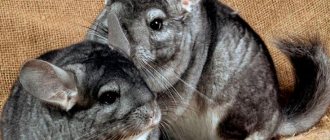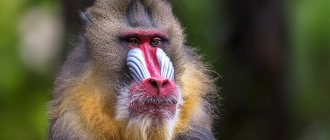- home
- Chinchilla
- Character and features
03/25/2019 Every chinchilla feels like a queen. Hence the character: royally rich in reactions and shades of behavior. Such animals are treated with care and individual traits are taken into account.
Are chinchillas smart?
Chinchillas learn commands less well than rats. However, they are not stupid, which is confirmed by interpersonal relationships in the pack. There are different sounds in the language of rodents:
- Calls: short, when the animal is looking for a fellow tribesman;
- communications: gentle murmurs when communicating with members of the pack;
- mating: from a squeak of resentment or soft notes that come from a male looking for a girlfriend;
- pleasure: made by the male after mating;
- demands: come from a hungry cub;
- complaints: crying of a chinchilla offended by its relatives;
- joy: when the cub is happy or has eaten;
- defense: short flashy;
- resistance: sound of protest;
- anger. An angry female is even capable of “shooting” urine at an object of irritation;
- problems between a male and a female: grunting signals from one and grinding sounds from the other;
- dangerous situation or pain: loud, sharp cry;
- danger alerts: “quacking.”
The cubs make a lot of sounds and can be heard almost constantly.
Treats for encouragement
To quickly assimilate commands, every correct action of the animal must be reinforced with a treat. During training, the most effective will be the use of chinchillas’ favorite treats:
- dried fruits;
- nuts:
- sunflower seeds;
- berries;
- dried fruits and vegetables.
In this case, the delicacies should be cut into small pieces - each one for one clove. This is necessary so that the chinchilla is not too distracted by snacks during classes.
Under no circumstances should you give your chinchilla sugar, chocolate, candy, salted seeds or crackers as a reward. Such treats will subsequently cause irreparable harm to the health of the animal.
Characteristics of a chinchilla
Unfortunately, some animals do not become tame. Therefore, take into account the character of the chinchilla in advance when purchasing: soft and trusting, or nasty and timid.
This is determined by where the chinchilla grew up and how it was treated. If the owner groomed and cherished her, she easily makes contact. Raised on chinchilla farms, individuals are distrustful of people.
The character of the pet also depends on its gender.
Habits of chinchillas of different sexes
Among them, the dominance of females is common, which they transfer to relationships with humans. Even if they are not too tame, you can negotiate with them. One has only to take into account the unpleasant skill: “shooting” urine at an annoying object.
Males make contact much simpler and easier. They are peaceful due to their position in the pack and their inability to “shoot.” However, do not underestimate them: in moments of panic, they are capable of biting the offender.
What is the character of a chinchilla?
Compared to rats, fluffy dogs are less susceptible to human influence. He interacts with his own kind, almost without needing human attention.
However, being a wayward and gentle creature, the animal requires care at times. The character of the animal has an important feature: trepidation, which softens it.
As a member of the royal family, the chinchilla requires appropriate treatment. For example, you should not touch or pull her tail: by doing this you risk losing a trusting relationship. The chinchilla will go into your arms when it decides that it is so convenient for it.
Contact with other animals
The nature of the relationship with other pets among chinchillas is different:
- with rodents: hamsters, guinea pigs - they quickly find a common language;
- they retain their characteristic coldness towards cats, but at the stage of getting used to each other, conflict situations are not excluded;
- Chinchillas have a warm relationship with dogs , but at a young age, animal contact should be kept under supervision.
Types of chinchilla temperaments
Like humans, rodents have 4 types of temperament.
Choleric
A real “battery with legs”. If he's not sleeping, he's always in action. Sleep occurs during the daytime and is interrupted by the slightest rustle. The movements are sharp, the gaze is constantly on guard, however, outwardly there are no signs of fear or anxiety. If you frighten a choleric person, he will begin to rush around in fear, not knowing his way. It is recommended to protect it from shocks.
Sanguine
Like a choleric person, he is active, but sleeps soundly during the day and is less timid. He is easy to train, he remembers commands well and carries them out readily.
Phlegmatic person
He moves little and sleeps soundly during the day. He prefers walking and frequent rest to running. He is less susceptible to stress, but is worse at remembering commands than a sanguine person.
Melancholic
The slowest of types. Its advantages are calmness, peaceful disposition, sound sleep. Disadvantages - craving for obesity, low learning ability, laziness.
Behavioral Signs of Stress
Chinchillas are susceptible to stress, which occurs under the influence of external or internal causes. Signs of stress in an animal include decreased appetite, decreased motor activity, avoidance of humans, and gnawing of fur. Learn more about stress factors and fur chewing >>> . Identify and eliminate stressors.
It happens that a wild chinchilla is not easy to handle; it will not bite or shoot urine, but will shed its fur. When you grab the animal, the fur will fall out at the point of contact with your hand. This is their protective natural instinct of “freeing themselves from the clutches of a predator.” Don't worry, the fur will grow back quickly. Try not to grab the chinchilla too harshly, especially not with a sudden movement from above.
Behavior of chinchillas at home
If the pet was recently acquired, or taken from a nursery, it is important to establish proper contact with it.
First, provide a spacious cage, food and leisure. Secondly, leave it alone for 2-3 days to adapt to new conditions.
After adaptation, you need to start establishing contact. It is acceptable to use affection, give him goodies, but do not touch him: this will cause stress, especially for an individual from the nursery.
The fact is that on chinchilla farms the animals are not treated very kindly, and in the first days they must get out of the habit of such treatment.
After gaining “credibility,” it is important to take the next step: observation. Just watch how your pet behaves. He can become playful, active and even noisy. This is normal and means successful adaptation.
Be prepared for the animal’s nightly “forays” and for insomnia from jumping, rearranging “furniture” and scattering hay and food. And if you want to cuddle your pet, don’t forget that he doesn’t take it well.
Other “bad” habits
Most chinchilla habits have a natural origin. Why does a chinchilla eat its own excrement and jump? Because it is so inherent in nature. The structure of their legs is designed for jumping and protection from predators, and due to the droppings, the intestinal activity of the animals is improved.
Falls over on its side
It is rare, but it happens that a chinchilla sleeps on its side simply because this is its favorite comfortable sleeping position.
There are other relatively harmless causes of such “fainting”:
- pregnancy;
- exhaustion and exhaustion;
- overheat.
We sleep as we want!
Rolling onto one side should be a cause for concern if it is accompanied by other symptoms of various pathologies:
- Stroke – aggression, inappropriate behavior, severe thirst, decreased appetite.
- Diseases of the cerebellum - vomiting, decreased chewing function, strabismus, no appetite.
- Rabies - when the animal falls on its side, it twitches.
If your chinchilla has not slept in this position before and if suspicious symptoms appear, you should immediately contact a veterinarian.
Grits his teeth
There can be many reasons for teeth grinding. Most often, the pet simply grinds down its teeth. If, in addition to the fact that the chinchilla grinds its teeth, nothing strange is observed in its behavior, then there is no reason for concern. If you suspect your animal is unwell, it is better to contact a veterinarian.
When the grinding is accompanied by a lack of appetite, it is necessary to check the health of the pet - perhaps he was poisoned by table salt, chemicals or a poisonous plant. In case of poisoning, the following are also observed:
- diarrhea;
- dilated pupils;
- paralysis;
- excessive salivation;
- thirst;
- blue mucous membranes.
Gnaws the cage
- Reasons why a chinchilla chews its cage and how to eliminate them:
- Boredom. It is necessary to give the animal walks, add toys and crawl spaces.
- Natural necessity. Sometimes it is enough to simply place other dental simulators in the cage - tree branches, mineral stones, wooden toys.
- Defensive reaction. If a chinchilla sheds its fur and chews on its cage, it means it wants to free itself. To make your pet friendly, you need to use various taming methods.
When choosing a cage, you must immediately ensure that your pet can chew on it. A cage made of hard wood (beech, etc.) is ideal.
Let me out of here! I want to go for a walk!
If your chinchilla is acting aggressively
In the wild, a rodent is prey for a predator. Hence the suspicious reaction to changes in diet, environment, etc. Almost always, animal aggression is associated with fear, pain or negative experience.
Important note: you should not cover the chinchilla with your palm, since the pet associates its shadow with the shadow of a bird of prey wanting to feast on “fresh food”.
Before biting, the animal gives signals of its intention. Pregnant females and those who have recently given birth become especially prone to aggression.
Biting symbolizes an attempt to establish contact with the object you like. However, a bite that draws blood indicates serious hostility. Grown-up males who want dominance can also test the owner’s teeth. In this case, it is recommended to stop the “power-hungry” by pushing him away from you with your palm or putting him in a cage.
An important point: the male should see the palm gently moved away, and not sharply withdrawn, as if in fright.
Biting or biting
Chinchilla biting is accompanied by other signs of aggression:
- growling or barking;
- deep dents on the hand;
- sudden movements.
Playful biting goes like this:
- no sounds;
- without pain;
- accompanied by sniffing and playing with fingers.
Let go of your tail or I'll bite you
Affectionate biting is accompanied by other signs of sympathy:
- sniffing;
- "massage";
- can lick with tongue;
- closing your eyes with pleasure;
- puts up its muzzle to be stroked.
Why does a chinchilla wag its tail?
Tail wagging expresses the male's desire to please the female. This is normal behavior.
The male can violently sweep the floor with his tail, regardless of who is nearby: an individual of the same sex or the opposite. Or wave them in a friendly manner, greeting the hostess and caressing the palm.
Sometimes he gets it from the female: the beloved begins to furiously chase him around the cage, waving her tail like a flag in the wind. In everyday life, both use the tail to enhance emotions, to ask or demand something.
Manifestations of aggression
When under stress, a chinchilla can become aggressive. We once bought a young female, brought her home, put her in a cage, and did not bother her for the first few days so that she could get used to the environment. The animal turned out to be wild; its previous owners did not tame it in any way. When trying to pick it up, the female stood up and shot out a stream of urine. Such an act is the highest degree of aggressiveness in chinchillas. We managed to gain trust with walks on the couch and pumpkin seeds. Read more about taming chinchillas>>> .
Chinchilla bites are not aggressive. Firstly, the chinchilla, like a rodent, tastes everything, including outstretched fingers. Secondly, an attack on a larger creature with an attempt to bite is not typical of rodents. It happens that chinchillas bite each other, showing dominance. Just in case, when handling an animal, do not put your hands near its face.
What else can you teach?
In addition to the listed tricks and commands, a chinchilla can be taught several more useful skills. This is not only interesting, but will also bring practical benefits to the owner. For example:
- Go to the toilet in one place . To do this, you will need to install a tray in the cage and pour filler only into it. At first, after each furry bowel movement, you will need to transfer the excrement to the “toilet”. This way the tray will gradually acquire the appropriate smell. After 1-2 months, the pet will develop the habit of going to the toilet in the designated place.
- Weigh yourself . As a rule, loving owners monitor the weight of their animals. However, sometimes this causes problems - many furries try to slip off the scale as quickly as possible. The training method is simple. Every time you weigh your chinchilla, you need to say “Scales” and give the animal a treat. After 3-4 weeks, the pet will go to weigh itself, having heard the appropriate command.
- Bathe . A chinchilla bathing suit is placed in the cage only for a certain period of time, since the pet may begin to throw sand in all directions. To prevent this from happening, you need to put a bathing suit in the cage and say: “Bathe.” If the fluffy performs the necessary actions, give him a treat. If not, leave the animal without a treat. Over time, the pet will understand what's what and will use the bathing suit exclusively for its intended purpose.
Knowing how to train a chinchilla at home, you can teach it not only interesting, but also useful tricks. The main thing is not to overdo it and show love and patience to your pet. And then he will not only quickly learn the commands, but will also reciprocate the owner’s feelings.











